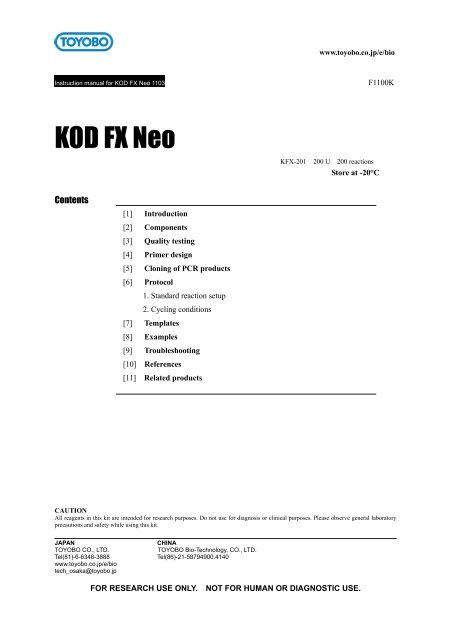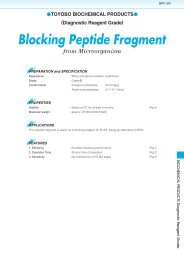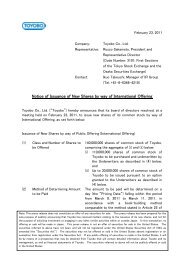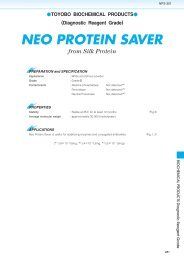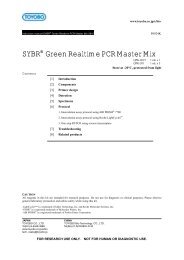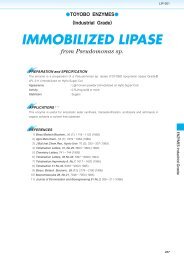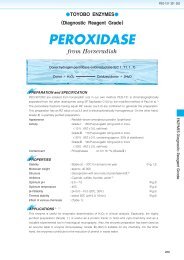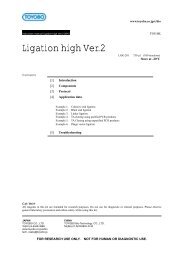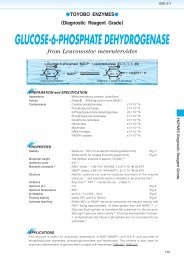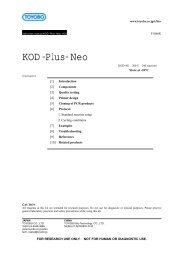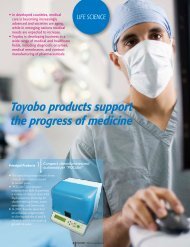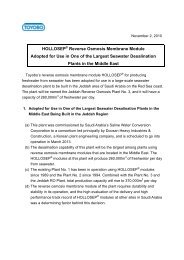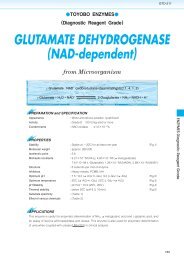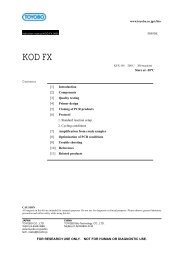KOD FX Neo - Toyobo
KOD FX Neo - Toyobo
KOD FX Neo - Toyobo
You also want an ePaper? Increase the reach of your titles
YUMPU automatically turns print PDFs into web optimized ePapers that Google loves.
www.toyobo.co.jp/e/bio[2] Components<strong>KOD</strong> <strong>FX</strong> <strong>Neo</strong> (1.0 U/μl) * 200 μl × 12× PCR Buffer for <strong>KOD</strong> <strong>FX</strong> <strong>Neo</strong>** 1.7 ml × 32 mM dNTPs 1 ml × 2*The enzyme solution contains anti-<strong>KOD</strong> DNA polymerase antibodies that neutralizethe polymerase and 3’5’ exonuclease activities.** 2× PCR Buffer for <strong>KOD</strong> <strong>FX</strong> <strong>Neo</strong> is a liquid (not frozen) when stored at -20°C.Although it does freeze below -20°C, the quality is not affected.[3] Quality TestingQuality testing is performed by amplification of the human β-globin gene (32 kb).[4] Primer Design-Primers should be 22–35 bases with a melting temperature (T m ) over 63°C.-Optimal GC content of primers is 45–60%. The ideal GC contents of the 5’ half and the3’ half are 60–70% and 45–50%, respectively.-The priming efficiency of primers can be promoted by anchoring the 3’end of primerswith G or C.-Primers should be designed so as not to generate intermolecular secondary structures orprimer dimers.-Primers for long target amplification should be 25–35 bases with Tm over 65°C.-Primers containing inosine cannot be used.-The Tm of primers should be calculated using the Nearest Neighbor method. The Tmvalues in this manual were calculated using this method with the following parameters.Na + concentration: 50 mMOligonucleotide concentration: 0.5 μM[5] Cloning of PCRproducts-<strong>KOD</strong> <strong>FX</strong> <strong>Neo</strong> generates blunt-end PCR products because of its 3’5’ exonuclease(proof-reading) activity. Therefore, PCR products can be cloned using blunt-end cloningmethods.-PCR products of <strong>KOD</strong> <strong>FX</strong> <strong>Neo</strong> should be purified prior to restriction enzyme treatmentsin cloning steps. The 3’5’ exonuclease activity of <strong>KOD</strong> DNA polymerase remains atthe end of the PCR reaction.-The dedicated TA cloning kit “TArget clone -Plus- (Code No. TAK-201)” isrecommended for the cloning of blunt end PCR products produced by <strong>KOD</strong> DNApolymerase (see [11] Related product).JAPANTOYOBO CO., LTD.Tel(81)-6-6348-3888www.toyobo.co.jp/e/biotech_osaka@toyobo.jpCHINATOYOBO Bio-Technology, CO., LTD.Tel(86)-21-58794900.4140FOR RESEARCH USE ONLY. NOT FOR HUMAN OR DIAGNOSTIC USE.2
www.toyobo.co.jp/e/bio[6] Protocol1. Standard reaction setupThe following protocol is designed for use with the components provided in this kit.Before preparing the mixture, all components should be completely thawed, except forthe enzyme solution.2mM dNTPs* 10 μl 0.4 mM each10pmol /μl Primer #1 1.5 μl 0.15–0.3 μM10pmol /μl Primer #2 1.5 μl 0.15–0.3 μMGenomic DNA ≤200 ng / 50 μlTemplate DNAY μl Plasmid DNA ≤50 ng / 50 μlcDNA ≤200 ng (RNA equiv.) / 50 μlCrude sample ≤0.5–2 μl/50 μl (see [ 7 ])<strong>KOD</strong> <strong>FX</strong> <strong>Neo</strong> (1.0U/μl) 1 μl 1.0 U / 50 μlTotal reaction volume50 μl* Do not use dNTPs from other kits or companies.Notes:Component Volume Final ConcentrationPCR grade water X μl 1×2x PCR buffer for <strong>KOD</strong> <strong>FX</strong> <strong>Neo</strong> 25 μl 1×-Optimal primer concentration is 0.3 μM. In the case of long targets (≥10 kb), areduced primer concentration (0.15 μM) may give more effective amplification.-For PCR reactions, thin-wall tubes are recommended. Reaction setup to a totalreaction volume of 50 μl is also recommended.-Crude samples (e.g., cultured animal cell suspension) should be added up to 2 μl foreach 50-μl reaction.2. Cycling conditionsTwo-step cycle conditions can be easily used for amplification using <strong>KOD</strong> <strong>FX</strong> <strong>Neo</strong>with primers ≥20 mer and Tm ≥68°C [recommended cycle]. If the Tm value of theprimer is under 68°C, the 3-step cycle condition is effective. For trouble shooting ofpoor amplification (no band, smear etc) or long target amplification (>10 kb), thestep-down cycle is recommended. The extension time should be set at 1 min./kb whencrude samples are used as templates.< 2-step cycle > For purified DNA For crude samples/cDNAPre-denaturation : 94°C, 2 min. 94°C, 2 min.Denaturation : 98°C, 10 sec. 98°C, 10 sec.Extension : 68°C, 30 sec. /kb 68°C, 1 min. /kb25–45 cyclesJAPANTOYOBO CO., LTD.Tel(81)-6-6348-3888www.toyobo.co.jp/e/biotech_osaka@toyobo.jpCHINATOYOBO Bio-Technology, CO., LTD.Tel(86)-21-58794900.4140FOR RESEARCH USE ONLY. NOT FOR HUMAN OR DIAGNOSTIC USE.3
www.toyobo.co.jp/e/bio< 3-step cycle > For purified DNA For crude samples/cDNAPre-denaturation : 94°C, 2 min. 94°C, 2 min.Denaturation : 98°C, 10 sec. 98°C, 10 sec.Annealing Tm °C*, 30 sec. Tm °C, 30 sec.Extension : 68°C,30 sec. /kb 68°C, 1 min. /kb25–45 cycles*Tm value of the primer.< Step-down cycle > For purified DNA For crude samples/cDNAPre-denaturation : 94°C,2 min. 94°C,2 min.Denaturation : 98°C,10 sec. 98°C,10 sec.Extension : 74°C,30 sec. /kb 74°C,1 min. /kbDenaturation : 98°C,10 sec. 98°C,10 sec.Extension : 72°C,30 sec. /kb 72°C,1 min. /kbDenaturation : 98°C,10 sec. 98°C,10 sec.Extension : 70°C,30 sec. /kb 70°C,1 min. /kbDenaturation : 98°C,10 sec. 98°C,10 sec.Extension : 68°C,30 sec. /kb 68°C,1 min. /kbExtension : 68°C,7 min. 68°C,7 min.5 cycles5 cycles5 cycles15–30 cyclesNotes:-For amplification from crude samples, the extension time should be 1 min./kb.-For amplification from a low copy DNA or for longer targets (> 10 kb), longerextension times may enhance the efficiency.-Poor amplification may be improved by changing the denaturation step to 94°C, 15sec.[7] Templatesa. Purified DNA or cDNAAppropriate template amounts for 50 μl reaction are summarized in the following table.Approved range RecommendedGenomic DNA Eukaryotic DNA 5–200 ng 50 ngProkaryotic DNA 0.1–100 ng 10 ngPlasmid DNA 10 pg–50 ng 1 ngcDNA< 200 ng (RNA equiv.) 50 ng (RNA equiv.)Lambda phage DNA 0.01–10 ng 1 ng-Contaminating RNA in cDNA or genomic DNA inhibits the PCR reaction by chelatingMg 2+ . PCR should be performed using template DNA containing
www.toyobo.co.jp/e/biob. Tissues and cellsWhen adding biological samples directly to the PCR reaction solution, the followingsamples can be applied to 50 μl reaction.Sample Appropriate template amount RemarksE. coli Picked small amount of cells from coloniesYeast Picked small amount of cells from coloniesFungus Picked small amount of cells from colonies When reproducibility is notgood, suspended cells in TEbuffer should be added (2–5 μl)Cultured cells 10 1 –10 5 cells/2 μl medium or PBSWhole Blood1–2 μlNail 1 × 1 mm As the concentration of extractedHair root 1–2 cm DNA is low, 35–40 cycles are needed.Leaf2 × 2 mmMilled rice0.5 × 0.5 mmMouse tail 1 × 1 mm On an agarose gel assay, a portionof amplicon may remain in the slots.*In the case of the direct amplification from animal tissues, such as mouse tail, a portionof the amplification product may remain in the gel slot on an agarose gel assay. Adding10 μl of 20 mg/ml proteinase K to 50 μl PCR products prior to the electrophoresis iseffective to dissociate the aggregates.c. LysateTo make the lysate for PCR, the following methods are recommended. The lysates can bestored at 4°C for several weeks. For long term storage, the lysates should be stored at-20°C.The following “Alkaline lysis method” is recommended for rapid preparation ofmouse tails or nail lysates suitable for amplification with <strong>KOD</strong> <strong>FX</strong> <strong>Neo</strong>.*Mouse tail cannot be dissolved completely.JAPANTOYOBO CO., LTD.Tel(81)-6-6348-3888www.toyobo.co.jp/e/biotech_osaka@toyobo.jpCHINATOYOBO Bio-Technology, CO., LTD.Tel(86)-21-58794900.4140FOR RESEARCH USE ONLY. NOT FOR HUMAN OR DIAGNOSTIC USE.5
www.toyobo.co.jp/e/bio[96-well PCR plate protocol by alkaline lysis method]The following protocol is useful for the preparation of lysates from a large number ofmouse tail samples.1. Transfer mouse tails (ca 3mm) to a 96-well PCR plate.2. Add 180 μl of 50mM NaOH and vortex.3. Spin down.4. Incubate at 95°C for 10 min using thermal cycler.5. Add 20 μl of 1M Tris-HCl (pH 8.0) and vortex.6. Spin down.Supernatant 0.5–2 μl PCR (50 μl)The following “Proteinase K method” is recommended for an efficient preparation ofmouse tails or nail lysates suitable for amplification with <strong>KOD</strong> <strong>FX</strong> <strong>Neo</strong>. This protocolcan also be applied to the following samples.Mouse tail: 3 mmNail: 3 mmLeaf: 3 × 3 mmA rice grainJAPANTOYOBO CO., LTD.Tel(81)-6-6348-3888www.toyobo.co.jp/e/biotech_osaka@toyobo.jpCHINATOYOBO Bio-Technology, CO., LTD.Tel(86)-21-58794900.4140FOR RESEARCH USE ONLY. NOT FOR HUMAN OR DIAGNOSTIC USE.6
www.toyobo.co.jp/e/bioThe following “One-step method” is recommended for the rapid preparation of aplant tissue lysate suitable for amplification with <strong>KOD</strong> <strong>FX</strong> <strong>Neo</strong>.The following “Homogenization method” is recommended for an effective preparationof a plant tissue lysate suitable for amplification with <strong>KOD</strong> <strong>FX</strong> <strong>Neo</strong>. This method iseffective for the amplification of genomic DNA targets.JAPANTOYOBO CO., LTD.Tel(81)-6-6348-3888www.toyobo.co.jp/e/biotech_osaka@toyobo.jpCHINATOYOBO Bio-Technology, CO., LTD.Tel(86)-21-58794900.4140FOR RESEARCH USE ONLY. NOT FOR HUMAN OR DIAGNOSTIC USE.7
www.toyobo.co.jp/e/bio[8] ExamplesExample 1. Amplification from crude samplesa. Whole blood samplesThe human β-globin gene (8.5 kb) was amplified using <strong>KOD</strong> <strong>FX</strong> <strong>Neo</strong> and <strong>KOD</strong> <strong>FX</strong>(previous version) with various amounts of blood (EDTA) specimens as templates.PCR was performed using 50 μl reaction solution contains 1–8 μl whole bloodsamples according to the standard protocol with 30 cycles. As a result, <strong>KOD</strong> <strong>FX</strong><strong>Neo</strong> successfully amplified the targets using 1–8 μl whole blood specimens.Next, the human β-globin gene (1.3 kb) was amplified using various PCR enzymeswith whole blood specimens containing citric acid and heparin as anticoagulants.<strong>KOD</strong> <strong>FX</strong> <strong>Neo</strong> amplified the targets efficiently from both whole blood samples.b. LeafTwo targets (2.2 and 4.6 kb) were amplified using lysates from tobacco leaves. EachPCR reaction was performed according to the recommended conditions with 35cycles. <strong>KOD</strong> <strong>FX</strong> <strong>Neo</strong> showed greater amplification from lysates prepared by the“one-step method”.Various targets were then directly amplified using small pieces of tobacco leaves (2× 2 mm). <strong>KOD</strong> <strong>FX</strong> <strong>Neo</strong> successfully amplified DNA using these templates.JAPANTOYOBO CO., LTD.Tel(81)-6-6348-3888www.toyobo.co.jp/e/biotech_osaka@toyobo.jpCHINATOYOBO Bio-Technology, CO., LTD.Tel(86)-21-58794900.4140FOR RESEARCH USE ONLY. NOT FOR HUMAN OR DIAGNOSTIC USE.8
www.toyobo.co.jp/e/bioExample 2.Elongation capabilityThe efficiency for long targets was compared between <strong>KOD</strong> <strong>FX</strong> <strong>Neo</strong> and <strong>KOD</strong> <strong>FX</strong>(previous version) using human genomic DNA as templates. The amplification wasperformed according to the standard protocol with a step-down cycle. <strong>KOD</strong> <strong>FX</strong> <strong>Neo</strong>successfully amplified targets of up to 40 kb.Example 3.Amplification efficiency and sensitivityThe human β-globin gene (8.5 kb) was amplified using the standard protocol with 40cycles. <strong>KOD</strong> <strong>FX</strong> <strong>Neo</strong> showed higher sensitivity than <strong>KOD</strong> <strong>FX</strong> (previous version). <strong>KOD</strong><strong>FX</strong> <strong>Neo</strong> can suppress the “plateau effect” on PCR after 20 cycles due to the “elongationenhancer”. Therefore, <strong>KOD</strong> <strong>FX</strong> <strong>Neo</strong> shows greater sensitivity than conventional reagentsin the range of 30–45 cycles during PCR.JAPANTOYOBO CO., LTD.Tel(81)-6-6348-3888www.toyobo.co.jp/e/biotech_osaka@toyobo.jpCHINATOYOBO Bio-Technology, CO., LTD.Tel(86)-21-58794900.4140FOR RESEARCH USE ONLY. NOT FOR HUMAN OR DIAGNOSTIC USE.9
www.toyobo.co.jp/e/bioExample 4.Amplification from mouse tail lysatesThe amplification efficiency was then compared between various PCR enzymes usingmouse tail lysates as templates. <strong>KOD</strong> <strong>FX</strong> <strong>Neo</strong> showed greater amplification efficiencythan the other enzymes.Example 5. PCR error ratioThe error ratio of various PCR enzymes were compared by determining the sequences ofthe amplicons from human β-globin gene. The amplicons were cloned into the vectorusing TArget clone -Plus- (Code No. TAK-201) and the sequences were determined.The result indicates that the error ratio of <strong>KOD</strong> <strong>FX</strong> <strong>Neo</strong> is equal to that of <strong>KOD</strong> <strong>FX</strong>(previous version) and approximately 10 times lower than rTaq DNA polymerase.Table. Comparison of the mutation frequency of each PCR enzyme.Fidelity was measured as a mutation frequency by sequencing the PCR product. After cloning, the PCRproduct (5.7 kb of the human β-globin region), about 96 clones were selected and sequenced.JAPANTOYOBO CO., LTD.Tel(81)-6-6348-3888www.toyobo.co.jp/e/biotech_osaka@toyobo.jpCHINATOYOBO Bio-Technology, CO., LTD.Tel(86)-21-58794900.4140FOR RESEARCH USE ONLY. NOT FOR HUMAN OR DIAGNOSTIC USE.10
www.toyobo.co.jp/e/bioExample 6 Extension time for crude samplesVarious targets were amplified using crude lysates with two cycling conditions (extensiontime: 30 sec./kb or 60 sec./kb). As a result, longer extension conditions gave greateramplification.Example 7 Preparation methods of crude lysatesAmplification efficiency was compared using various lysates from mouse tail andtobacco leaf lysates. For mouse tail lysates, the alkaline lysis method and proteinase Kmethod gave superior results. For plant lysates, the one-step and proteinase k methodsshowed superior results.JAPANTOYOBO CO., LTD.Tel(81)-6-6348-3888www.toyobo.co.jp/e/biotech_osaka@toyobo.jpCHINATOYOBO Bio-Technology, CO., LTD.Tel(86)-21-58794900.4140FOR RESEARCH USE ONLY. NOT FOR HUMAN OR DIAGNOSTIC USE.11
www.toyobo.co.jp/e/bioApplication data:Amplification using soil specimens.Inhibitory effect of humic acid was compared between various PCR enzymes. Humicacid is the major organic constituent of soil or compost. It is produced by biodegradationof dead organic matters. The humic acid can be hardly separated from DNA onpurification and inhibits PCR.The results indicate that <strong>KOD</strong> <strong>FX</strong> <strong>Neo</strong> can amplify targets under high concentrations ofhumic acid.rDNA was amplified from roughly prepared extracts from 100 mg compost specimensusing the alkaline method [see p5] using various PCR enzymes. In this experiment, threeprimer sets for prokaryote, Bacillus sp. and high G/C gram-negative bacteria were used.The results indicate that <strong>KOD</strong> <strong>FX</strong> <strong>Neo</strong> is the only PCR reagent can amplify all targets.JAPANTOYOBO CO., LTD.Tel(81)-6-6348-3888www.toyobo.co.jp/e/biotech_osaka@toyobo.jpCHINATOYOBO Bio-Technology, CO., LTD.Tel(86)-21-58794900.4140FOR RESEARCH USE ONLY. NOT FOR HUMAN OR DIAGNOSTIC USE.12
www.toyobo.co.jp/e/bio[9] TroubleshootingSymptom Cause SolutionNo PCR product / low yieldSmearing / Extra bandPoor TA cloning efficiencyCycling condition is notsuitable.Template DNA is not goodin quality and /or quantity.Primer is not good.Enzyme concentration islow.Cycling conditions are notsuitable.Too much template DNA.Quality of primers is notsufficient.Too much enzymePCR products haveblunt-ends.Increase the extension time up to 60 sec./kb.Increase the number of cycles by 2–5 cycles.Use a 3-step cycle instead of a 2-step cycle.Lower annealing temperature in the 3-step cyclingdecrements up to Tm-5–10°C.Use a step-down cycle.(This solution is effective for long targets over 10kb)Increase the amount of template DNA.Decrease the amount of template DNA to reducethe contaminated PCR inhibitors.Use purified templates.Decrease the amount of cDNA to reduce theinhibition by contaminated RNA.Degrade or eliminate RNA in the DNA sample.Decrease the primer concentration from 0.3 mM to0.15 μM.(This solution may be effective for theamplification of targets over 10 kb)Use fresh primers.Redesign primers.Increase enzyme concentration to 1.5–2.0 U/ 50 μl.Change from 3-step cycling to 2-step cycling.Change from 2-step cycling to step-down cycling.Decrease the number of cycles by 2–5 cycles.Reduce the amount of template DNA.Use fresh primers.Redesign primers.(Longer primers may eliminate smearing or extrabands)Reduce Enzyme to 0.5–0.8U/ 50μl reactionClone the PCR products according to generalblunt-end cloning guide lines.Use TArget Clone -Plus- (Code No. TAK-201)[see related products]JAPANTOYOBO CO., LTD.Tel(81)-6-6348-3888www.toyobo.co.jp/e/biotech_osaka@toyobo.jpCHINATOYOBO Bio-Technology, CO., LTD.Tel(86)-21-58794900.4140FOR RESEARCH USE ONLY. NOT FOR HUMAN OR DIAGNOSTIC USE.13
www.toyobo.co.jp/e/bio[10] References1) Takagi M, Nishioka M, Kakihara H, Kitabayashi M, Inoue H, Kawakami B, Oka M,and Imanaka T., Appl Environ Microbiol., 63: 4504-10 (1997)2) Hashimoto H, Nishioka M, Fujiwara S, Takagi M, Imanaka T, Inoue T and Kai Y, JMol Biol., 306: 469-77 (2001)3) Mizuguchi H, Nakatsuji M, Fujiwara S, Takagi M and Imanaka T, J Biochem., 126:762-8 (1999)[ 11 ] Related productsProduct name Package Code No.TArget Clone -Plus- 10 reactions TAK-20110× A-attachment mix 25 reactions TAK-301Ligation high Ver.2750 μl(100 reactions)LGK-201TArget Clone -Plus- is a highly efficient TA cloning kit. The kit can be applied to the TAcloning of blunt-ended PCR products amplified using <strong>KOD</strong> -Plus- [Code No. <strong>KOD</strong>-201],<strong>KOD</strong> -Plus- <strong>Neo</strong> [Code No. <strong>KOD</strong>-401], <strong>KOD</strong> <strong>FX</strong> [Code No. K<strong>FX</strong>-101] or <strong>KOD</strong> <strong>FX</strong> <strong>Neo</strong>[Code No. K<strong>FX</strong>-201]. The kit contains pTA2 Vector, 2x Ligation Buffer, T4 DNA Ligase,and 10× A-attachment Mix.10× A-attachment mix is a reagent comprising anti-<strong>KOD</strong> DNA polymerase antibodyspecific to <strong>KOD</strong> 3’5’ exonuclease activity (proof-reading activity), as well as Taq DNApolymerase, which exhibits terminal transferase activity. PCR products from <strong>KOD</strong> -Plus-[Code No. <strong>KOD</strong>-201], <strong>KOD</strong> -Plus- <strong>Neo</strong> [Code No. <strong>KOD</strong>-401], <strong>KOD</strong> <strong>FX</strong> [Code No.K<strong>FX</strong>-101] and <strong>KOD</strong> <strong>FX</strong> <strong>Neo</strong> [Code No. K<strong>FX</strong>-201]. possess blunt ends due to 3’5’exonuclease activity of the <strong>KOD</strong> DNA polymerase. The 10× A-attachment mix allows forPCR products to acquire overhanging dA at the 3’-ends. Products with 3’-dAoverhangs can be directly cloned into arbitrary T-vectors using ligation reagents, such asLigation high Ver.2 [Code No. LGK-201].<strong>KOD</strong> DNA polymeraseAnti-<strong>KOD</strong> DNA polymeraseantibodyPCR productInhibition of theproof-readingacitivityAAAddition of dATaq DNA polymeraseFigure.Principle of the 10× A-attachment mixJAPANTOYOBO CO., LTD.Tel(81)-6-6348-3888www.toyobo.co.jp/e/biotech_osaka@toyobo.jpCHINATOYOBO Bio-Technology, CO., LTD.Tel(86)-21-58794900.4140FOR RESEARCH USE ONLY. NOT FOR HUMAN OR DIAGNOSTIC USE.14
www.toyobo.co.jp/e/bioNOTICE TO PURCHASER: LIMITED LICENSEUse of this product is covered by one or more of the following US patents and corresponding patent claims outside the United States:5,079,352, 5,789,224, 5,618,711, 6,127,155 and claims outside the United States corresponding to US Patent No. 4,889,818. The purchaseof this product includes a limited, non-transferable immunity from suit under the foregoing patent claims for using only this amount ofproduct for the purchaser’s own internal research. No right under any other patent claim (such as the patented 5’ Nuclease Process claims inUS Patent Nos. 5,210,015 and 5,487,972), no right to perform any patented method, and no right to perform commercial services of anykind, including without limitation reporting the results of purchaser's activities for a fee or other commercial consideration, is conveyedexpressly, by implication, or by estoppel. This product is for research use only. Diagnostic uses under Roche patents require a separatelicense from Roche. Further information on purchasing licenses may be obtained by contacting the Director of Licensing, AppliedBiosystems, 850 Lincoln Centre Drive, Foster City, California 94404, USA.The use of betaine in DNA polymerase reactions is covered by intellectual property, including U.S. Patent No. 6,270,962 and related patentsissued or pending in other countries ("I.P."), exclusively licensed to EPICENTRE Technologies Corporation, 726 Post Road, Madison, WI53713, USA ("EPICENTRE"). The right to use betaine in conjunction with <strong>KOD</strong> DNA Polymerase in PCR is sublicensed by EPICENTREto TOYOBO Co., Ltd. solely for research purposes. The purchase of this product conveys to the buyer a limited, non-exclusive,non-transferable right under the I.P. to use the purchased product containing betaine and <strong>KOD</strong> DNA polymerase in PCR solely for researchpurposes. No rights are granted to resell, repackage, or further sublicense. No other license is granted to the buyer, whether expressly, byimplication, by estoppel or otherwiseJAPANTOYOBO CO., LTD.Tel(81)-6-6348-3888www.toyobo.co.jp/e/biotech_osaka@toyobo.jpCHINATOYOBO Bio-Technology, CO., LTD.Tel(86)-21-58794900.4140FOR RESEARCH USE ONLY. NOT FOR HUMAN OR DIAGNOSTIC USE.15


